
Four features on tap today – a lot of combined viewing time – with one semi-clinker and some other quite worthwhile entries, all featuring circus fare.
 First, the clinker. Filmation’s Pinocchio and the Emperor of the Night (8/6/87), or, “How To Produce a Sequel When You Never Owned Or Paid For The Original”. Simply alter up the designs and color schemes of your principal characters, substitute characters with parallel personalities and/or voices for the remaining supporting cast, and graft a hackneyed story upon the whole mish-mash – without paying a dime in royalties. Filmation would do this at least twice, ending the studio’s history with the disastrous Snow White sequel, “Happily Ever After.” This one, in all fairness, is not quite so bad – at least by Filmation standards. Animation is sometimes smooth, with designs at least rising to the level of an ABC Afterschool Special, and comparably favorable as compared to contemporary 2D offerings from Rankin-Bass. Voice talent is star-studded, and particularly highlighted by the appearance of Don Knotts as Willikers – a carved wooden insect brought to life by the Blue Fairy as Pinocchio’s new conscience/guardian. Knotts does a remarkable non-singing impression of Cliff Edwards’s reads and intonations, sometimes making one forget Edwards is not in the role. Parallel roles to the fox and cat are provided by a con-man raccoon (Professor Scalawag, voiced by Ed Asner) and organ-grinder monkey (Igor, voiced by Frank Welker). And there is of course puppet-show homage galore, though no direct parallel to the Monstro the Whale angle. Unlike a Disney sequel, box office was not tremendous, the public seeing through the thin Disney-disguise to know that the film wasn’t a genuine article. Still, it didn’t do so badly that the studio was convinced not to try again – more’s the pity for such managerial decision, as the next feature would, as referenced above, be the studio’s Waterloo.
First, the clinker. Filmation’s Pinocchio and the Emperor of the Night (8/6/87), or, “How To Produce a Sequel When You Never Owned Or Paid For The Original”. Simply alter up the designs and color schemes of your principal characters, substitute characters with parallel personalities and/or voices for the remaining supporting cast, and graft a hackneyed story upon the whole mish-mash – without paying a dime in royalties. Filmation would do this at least twice, ending the studio’s history with the disastrous Snow White sequel, “Happily Ever After.” This one, in all fairness, is not quite so bad – at least by Filmation standards. Animation is sometimes smooth, with designs at least rising to the level of an ABC Afterschool Special, and comparably favorable as compared to contemporary 2D offerings from Rankin-Bass. Voice talent is star-studded, and particularly highlighted by the appearance of Don Knotts as Willikers – a carved wooden insect brought to life by the Blue Fairy as Pinocchio’s new conscience/guardian. Knotts does a remarkable non-singing impression of Cliff Edwards’s reads and intonations, sometimes making one forget Edwards is not in the role. Parallel roles to the fox and cat are provided by a con-man raccoon (Professor Scalawag, voiced by Ed Asner) and organ-grinder monkey (Igor, voiced by Frank Welker). And there is of course puppet-show homage galore, though no direct parallel to the Monstro the Whale angle. Unlike a Disney sequel, box office was not tremendous, the public seeing through the thin Disney-disguise to know that the film wasn’t a genuine article. Still, it didn’t do so badly that the studio was convinced not to try again – more’s the pity for such managerial decision, as the next feature would, as referenced above, be the studio’s Waterloo.
Pinocchio, now a real boy, is assigned the task of delivering to the mayor a hand-made jewel box, for a price of ten gold pieces. (A little out of Gepetto (Tom Bosley)’s usual line of manufacture.) On the way, he spots a circus/carnival in the distance, and encounters Scalawag and Igor, who are fleeing an angry mob after running a rigged shell game at the circus grounds. They exit by having themselves fired out of the circus cannon and out of the reach of their pursuers. They fast-talk Pinocchio into a trade of the jewelry box for a “priceless” ruby that of course is merely glass.
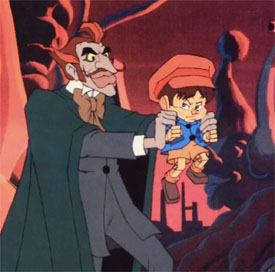 Having let his father down once again, Pinocchio decides he will be a bother to his father no longer, by running away to join the circus. The film turns out to have quire little to actually do with circus goings-on, using the setting only as framework for the presentation of a puppet show by the great Puppetino, featuring the world’s most beautiful pippet, a young girl marionette named Twinkle. Pinocchio is smitten with her, and makes the acquaintance of Puppetino, who has caught Pinocchio’s act before (back in Stromboli’s day, though the gypsy puppeteer is not mentioned). He recalls our hero’s name incorrectly, as Pistachio. Pinocchio points out he is now a real boy, but Puppetino believes he still has star power nonetheless. As he talks Pinocchio into coming up on stage to perform, Puppetino begins cranking a tune from a high-powered organ-grinder’s box. The more Pinocchio gets into dancing to the tune, the more he can’t stop, and his arms and legs begin to transform back to wooden form. Before he knows it, he is a lifeless marionette, with strings again tied around his limbs by Puppetino. Eventually he is rescued and transformed back by the Blue Fairy, who, disappointed, tells him that he treated his freedom too lightly, and that making the wrong choices can cause him to lose his freedom. Pinocchio promises to be more careful.
Having let his father down once again, Pinocchio decides he will be a bother to his father no longer, by running away to join the circus. The film turns out to have quire little to actually do with circus goings-on, using the setting only as framework for the presentation of a puppet show by the great Puppetino, featuring the world’s most beautiful pippet, a young girl marionette named Twinkle. Pinocchio is smitten with her, and makes the acquaintance of Puppetino, who has caught Pinocchio’s act before (back in Stromboli’s day, though the gypsy puppeteer is not mentioned). He recalls our hero’s name incorrectly, as Pistachio. Pinocchio points out he is now a real boy, but Puppetino believes he still has star power nonetheless. As he talks Pinocchio into coming up on stage to perform, Puppetino begins cranking a tune from a high-powered organ-grinder’s box. The more Pinocchio gets into dancing to the tune, the more he can’t stop, and his arms and legs begin to transform back to wooden form. Before he knows it, he is a lifeless marionette, with strings again tied around his limbs by Puppetino. Eventually he is rescued and transformed back by the Blue Fairy, who, disappointed, tells him that he treated his freedom too lightly, and that making the wrong choices can cause him to lose his freedom. Pinocchio promises to be more careful.
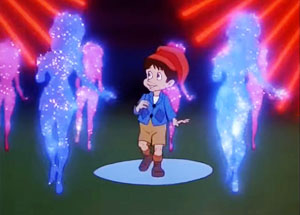 Things devolve into weird nonsense from here. Pinocchio meets up with Scalawag and Igor once again, who feign surprise at learning the ruby was fake, but without clear explanation let drop that the jewel box is somewhere at the carnival, claiming that a gang of thieves waylaid them for it. Willikers spends much time separated from Pinocchio, but manages to keep up, with the assistance of Lieutenant Grumblebee of the R.A.B. (Royal Air Bugs), voiced by Jonathan Harris (of “Lost in Space”), who provides additional effective comic relief. The circus is packing up, rolling into a huge steamship, where the wagons seem to simply disappear into the blackness. Pinocchio, with Scalawag and Igor aboard, pilots a small paddlewheel vessel directly into the cargo bay of the ship and is swallowed up too, into the dark realm of the Emperor of the Night (an evil counterpart to the Blue Fairy, in devil-like looming red form reminiscent of Fantasia’s “Night On Bald Mountain” demon, and voiced by James Earl Jones). An incidental gondolier appears to first divert Pinocchio from his quest for the jewel box to an equivalent of pleasure island in the form of a neon café, where time is wasted granting Pinocchio’s every wish, and placing him in a stage show with Twinkle, all at the mere price of signing an agreement afterwards – an agreement to give up his life powers and free will forever. The Emperor is the real boss behind Puppetino and the circus, and uses it as a means to deprive others of free will through bad decisions too – a loss that he claims drains the powers of the Blue Fairy, his arch rival, and strengthens his own powers at the same time. When presented with the contract, Pinocchio also observes that his entire audience during the previous performance had in reality been lifeless puppets, victims of the Emperor’s prior conquests. Pinocchio rebels, refusing to sign. The Emperor shows him the jewel box, with a “surprise “ inside – Gepetto, shrunken to miniature toy size, captured while out looking for his son. The Emperor indicates that Pinocchio will be hs prize – the only puppet ever to be a real boy, resulting in a drain on the Blue Fairy’s power that may prove her undoing. Nevertheless, in return for a promise to set Gepetto and all his friends free, Pinocchio signs the agreement. However, as he is transforming to wood again, he overhears the Emperor ordering everyone into the dungeon, and reneging on his end of the deal. Pinocchio finds the strength of will to regain his thinking powers in the face of the Emperor’s betrayal, and stops transforming any farther. His courage growing, he also becomes bathed in a bright blue light which envelops him, seemingly protecting him from further harm by the Emperor. It is the energy of the Blue Fairy, from which the Emperor pulls back, literally beginning to shrink in size. Puppetino offers little to help the Emperor, and for his cowardice is transformed by the Emperor into a puppet himself. Pinocchio’s comrades begin to flee the ship, as the Emperor uses his remaining power to set the ship afire. Pinocchio stands his ground, and ultimately rolls his ball of energy to the Emperor’s toes and up his robes, coming to rest at the Emperor’s midriff. The Emperor painfully transforms to a writhing mass of blue himself, and explodes along with the remains of the ship. His power breaks, and Gepetto is returned to normal size.
Things devolve into weird nonsense from here. Pinocchio meets up with Scalawag and Igor once again, who feign surprise at learning the ruby was fake, but without clear explanation let drop that the jewel box is somewhere at the carnival, claiming that a gang of thieves waylaid them for it. Willikers spends much time separated from Pinocchio, but manages to keep up, with the assistance of Lieutenant Grumblebee of the R.A.B. (Royal Air Bugs), voiced by Jonathan Harris (of “Lost in Space”), who provides additional effective comic relief. The circus is packing up, rolling into a huge steamship, where the wagons seem to simply disappear into the blackness. Pinocchio, with Scalawag and Igor aboard, pilots a small paddlewheel vessel directly into the cargo bay of the ship and is swallowed up too, into the dark realm of the Emperor of the Night (an evil counterpart to the Blue Fairy, in devil-like looming red form reminiscent of Fantasia’s “Night On Bald Mountain” demon, and voiced by James Earl Jones). An incidental gondolier appears to first divert Pinocchio from his quest for the jewel box to an equivalent of pleasure island in the form of a neon café, where time is wasted granting Pinocchio’s every wish, and placing him in a stage show with Twinkle, all at the mere price of signing an agreement afterwards – an agreement to give up his life powers and free will forever. The Emperor is the real boss behind Puppetino and the circus, and uses it as a means to deprive others of free will through bad decisions too – a loss that he claims drains the powers of the Blue Fairy, his arch rival, and strengthens his own powers at the same time. When presented with the contract, Pinocchio also observes that his entire audience during the previous performance had in reality been lifeless puppets, victims of the Emperor’s prior conquests. Pinocchio rebels, refusing to sign. The Emperor shows him the jewel box, with a “surprise “ inside – Gepetto, shrunken to miniature toy size, captured while out looking for his son. The Emperor indicates that Pinocchio will be hs prize – the only puppet ever to be a real boy, resulting in a drain on the Blue Fairy’s power that may prove her undoing. Nevertheless, in return for a promise to set Gepetto and all his friends free, Pinocchio signs the agreement. However, as he is transforming to wood again, he overhears the Emperor ordering everyone into the dungeon, and reneging on his end of the deal. Pinocchio finds the strength of will to regain his thinking powers in the face of the Emperor’s betrayal, and stops transforming any farther. His courage growing, he also becomes bathed in a bright blue light which envelops him, seemingly protecting him from further harm by the Emperor. It is the energy of the Blue Fairy, from which the Emperor pulls back, literally beginning to shrink in size. Puppetino offers little to help the Emperor, and for his cowardice is transformed by the Emperor into a puppet himself. Pinocchio’s comrades begin to flee the ship, as the Emperor uses his remaining power to set the ship afire. Pinocchio stands his ground, and ultimately rolls his ball of energy to the Emperor’s toes and up his robes, coming to rest at the Emperor’s midriff. The Emperor painfully transforms to a writhing mass of blue himself, and explodes along with the remains of the ship. His power breaks, and Gepetto is returned to normal size.
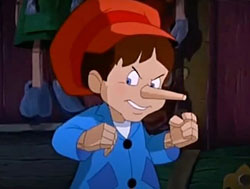 On the banks of the bay, as dawn breaks (a signal that the night powers of the Emperor are gone), Gepetto, the two con-men, Willikers and Grumblebee discover Pinocchio, face down in the sand, but thankfully very much alive, and returned to form as a real boy. Pinocchio receives a surprise, as the marionette of Twinkle is discovered also – but also transformed into a live young girl. The Blue Fairy appears, responsible for Twinkle’s transformation, and commending Pinocchio on risking his own life to save his friends, and declares that she believes Pinocchio will need her help no longer. The jewel box is rescued too, which Pinocchio presents back to his father, receiving a warm hug. All ends happily as the cast sets off down the road, for home sweet home and a fade out.
On the banks of the bay, as dawn breaks (a signal that the night powers of the Emperor are gone), Gepetto, the two con-men, Willikers and Grumblebee discover Pinocchio, face down in the sand, but thankfully very much alive, and returned to form as a real boy. Pinocchio receives a surprise, as the marionette of Twinkle is discovered also – but also transformed into a live young girl. The Blue Fairy appears, responsible for Twinkle’s transformation, and commending Pinocchio on risking his own life to save his friends, and declares that she believes Pinocchio will need her help no longer. The jewel box is rescued too, which Pinocchio presents back to his father, receiving a warm hug. All ends happily as the cast sets off down the road, for home sweet home and a fade out.
.
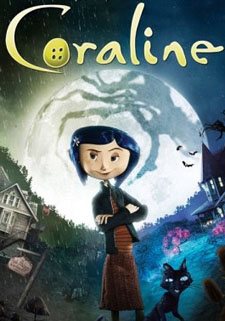 It is hard to describe Laika’s stop-motion feature Coraline (2/6/09) in terms that make a fully-coherent storyline. Yet, it somehow conveys an eerie, macabre mood that draws the viewer in, and punches it up enough with periodic humor and outlandish situations to keep one intrigued, wondering what can come next. It would appear to be significantly influenced by the stop-motion work of Tim Burton, similar in style and presentation. Its animation can be called “Laika in training”, not nearly measuring up to the utter smoothness of later works such as “Paranorman” and “The Box Trolls”, but attempting to get there. And its character personalities are varied and well-endowed with spunkiness and unique quirks, making for o rich goulash of entertainment that, while it leaves one scratching one’s head at the end of the story as to exactly just what happened, still leaves a reasonably tantalizing flavor in one’s mouth of 90 minutes enjoyably spent.
It is hard to describe Laika’s stop-motion feature Coraline (2/6/09) in terms that make a fully-coherent storyline. Yet, it somehow conveys an eerie, macabre mood that draws the viewer in, and punches it up enough with periodic humor and outlandish situations to keep one intrigued, wondering what can come next. It would appear to be significantly influenced by the stop-motion work of Tim Burton, similar in style and presentation. Its animation can be called “Laika in training”, not nearly measuring up to the utter smoothness of later works such as “Paranorman” and “The Box Trolls”, but attempting to get there. And its character personalities are varied and well-endowed with spunkiness and unique quirks, making for o rich goulash of entertainment that, while it leaves one scratching one’s head at the end of the story as to exactly just what happened, still leaves a reasonably tantalizing flavor in one’s mouth of 90 minutes enjoyably spent.
Coraline (who has a constant irksome problem of everyone mispronouncing her name as Caroline) is a pre-teen girl uprooted from her home by a somewhat-unexplained relocation of her parents to a remote, ages-old apartment house in the middle of a thickly-forested area, called the Pink Palace Apartments. Though the faded paint still holds some resemblance to pink, the name can hardly be said to be fitting for what is left of the structure – a gabled, oversized home now subdivided unto at least three units, with stained ceilings, cracking plaster, creaking wooden staircases, and drab gray interior colors. The exterior surroundings are not much more inviting, gray and prone to rain. Coraline fruitlessly searches for any sign of liveliness and something to break the boredom. But her mother, recuperating from some sort of neck accident, doesn’t move around much so as to offer companionship to Coraline, is preoccupied with work on some sort of catalogue so that she barely has time to prepare meals from meager foodstocks she has remaining in the kitchen from sporadic trips to the store, and is mostly upset with Coraline’s difficulty in adjusting to the new situation. Dad is also consumed by work of his own on another PC, and doesn’t appear to have time for anything else in his quest to make ends meet.
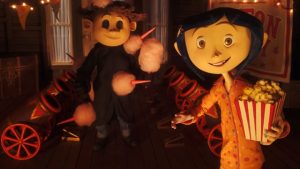 The neighbors don’t offer much in the way of alternative company. A young boy about Coraline’s age is in the viciniy, but he does his own creepy things like follow behind her in the underbrush on a souped-up bike, wearing a semi-frightening biker mask, and Coraline brands him as a “stalker”. The other tenants of the Apartments consist of washed-up ex-show folk. A Russian-accented former acrobat lives upstairs, now reduced to sweaty T-shirt and frizzled moustache, who seems a bit off as to his possible sanity, constantly claiming that he will stage a comeback with the training of a jumping mouse circus, but never showing off his proteges, claiming the project is still a work in progress. Below in the basement apartment live an old pair of women who claim to have been theater performers – probably in 1892 – well past their age of being capable of holding an audience, and now content to putter around the house brewing tea and wallowing in memories of their past glory, accompanied by three Scottie dogs, and a China cabinet holding instead of dishes a collection of their terriers of the past (whom they couldn’t bear to part with, so had each stuffed and dressed in homemade angel robes with wings attached). Finally, there is an emaciated-looking black cat, who seems to prowl everywhere randomly, always with his yellow eyes on everything. Quite the atmosphere to liven a young-girl’s heart, say what?
The neighbors don’t offer much in the way of alternative company. A young boy about Coraline’s age is in the viciniy, but he does his own creepy things like follow behind her in the underbrush on a souped-up bike, wearing a semi-frightening biker mask, and Coraline brands him as a “stalker”. The other tenants of the Apartments consist of washed-up ex-show folk. A Russian-accented former acrobat lives upstairs, now reduced to sweaty T-shirt and frizzled moustache, who seems a bit off as to his possible sanity, constantly claiming that he will stage a comeback with the training of a jumping mouse circus, but never showing off his proteges, claiming the project is still a work in progress. Below in the basement apartment live an old pair of women who claim to have been theater performers – probably in 1892 – well past their age of being capable of holding an audience, and now content to putter around the house brewing tea and wallowing in memories of their past glory, accompanied by three Scottie dogs, and a China cabinet holding instead of dishes a collection of their terriers of the past (whom they couldn’t bear to part with, so had each stuffed and dressed in homemade angel robes with wings attached). Finally, there is an emaciated-looking black cat, who seems to prowl everywhere randomly, always with his yellow eyes on everything. Quite the atmosphere to liven a young-girl’s heart, say what?
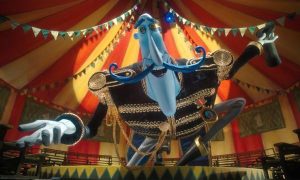 Things get weirder when Coraline, out of sheer lack of anything else to do, is told by her Dad to explore the apartment, inventorying it for windows, doors, etc. Coraline discovers a small door, approximating the type one might find in “Alice in Wonderland”, only big enough to crawl through, if it were opened. The door, however, has been wallpapered over, and when Mom, at Coraline’s request, finds an old key to it in a drawer, Coraline finds inside the door only a bricked-up wall, which Mom suggests must have been put up when the house was subdivided. Another strange happenstance occurs. The neighbor boy presents Coraline with a strange doll, which his grandmother just located, previously unnoticed among the effects of a sister who disappeared as a child. The doll looks like a rag ringer for the features and hair of Coraline, with black shoe buttons sewn on the face for eyes. Coraline thinks this weird, but nevertheless begins to keep the doll around her room as a sort of mascot.
Things get weirder when Coraline, out of sheer lack of anything else to do, is told by her Dad to explore the apartment, inventorying it for windows, doors, etc. Coraline discovers a small door, approximating the type one might find in “Alice in Wonderland”, only big enough to crawl through, if it were opened. The door, however, has been wallpapered over, and when Mom, at Coraline’s request, finds an old key to it in a drawer, Coraline finds inside the door only a bricked-up wall, which Mom suggests must have been put up when the house was subdivided. Another strange happenstance occurs. The neighbor boy presents Coraline with a strange doll, which his grandmother just located, previously unnoticed among the effects of a sister who disappeared as a child. The doll looks like a rag ringer for the features and hair of Coraline, with black shoe buttons sewn on the face for eyes. Coraline thinks this weird, but nevertheless begins to keep the doll around her room as a sort of mascot.
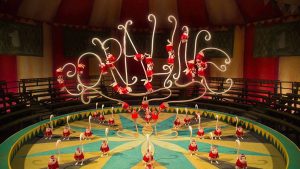 One night, Coraline is awakened from her sleep by a sound within her room. Of all things, a jumping mouse. Coraline follows the creature down the stairs, and into the room with the tiny, sealed-up door. Amazingly, the mouse disappears into a small crack where the door is ajar. When Coraline opens the door, the brick wall is gone. Instead, a tunnel, seemingly constructed of cloth covering and expanding metal hoop structure, expands out before her, with the other end not immediately visible. Irresistibly, Coraline crawls through. She comes out through another door that seems to be a twin to the one she entered, but things look somehow different. Boring portraits on the wall now have assumed more interesting poses. A friendly yellow glowing light pierces the darkness from the kitchen. Peering into it, Coraline discovers what appears to be her Mom, no longer wearing a neck brace, humming and busily working away at the oven, preparing a bountiful and good-smelling meal. “Mom?”. asks Coraline. Mom’s smiling face turns to welcome her – but though the face is familiar, one thing is startling different.
One night, Coraline is awakened from her sleep by a sound within her room. Of all things, a jumping mouse. Coraline follows the creature down the stairs, and into the room with the tiny, sealed-up door. Amazingly, the mouse disappears into a small crack where the door is ajar. When Coraline opens the door, the brick wall is gone. Instead, a tunnel, seemingly constructed of cloth covering and expanding metal hoop structure, expands out before her, with the other end not immediately visible. Irresistibly, Coraline crawls through. She comes out through another door that seems to be a twin to the one she entered, but things look somehow different. Boring portraits on the wall now have assumed more interesting poses. A friendly yellow glowing light pierces the darkness from the kitchen. Peering into it, Coraline discovers what appears to be her Mom, no longer wearing a neck brace, humming and busily working away at the oven, preparing a bountiful and good-smelling meal. “Mom?”. asks Coraline. Mom’s smiling face turns to welcome her – but though the face is familiar, one thing is startling different.
She stares at Coraline with a pair of black, shoe-button eyes sewn into her sockets! She corrects, Coraline, calling her referring to her as “Mom” silly. “I’m your other mother”, she clarifies, claiming that everybody has one. While she continues to prepare dinner, she suggests that the puzzled Coraline look in on her “other Dad”. Having no idea what to expect next, Coraline looks into Dad’s study, expecting to find Dad as usual bent over the PC. Instead, Dad, in a colorful robe, is playing a magical piano – or rather, the piano is playing him, manipulating his hands to play the keys with a pair of mechanical gloves on extensions placed around his hands. This is so unusual a sight that Coraline cannot help but enjoy the break in mood, brought about by Dad’s original song composed about Coraline, and can almost overlook that other Dad also has a pair of button eyes. Other Mom calls everyone to the table for dinner, and a glorious feast of roast chicken with all kinds of vegetables, sides, and desserts is served, complete with gravy delivered by a “gravy train” – a miniature railroad engine riding on a track right around the main courses. Coraline can never quite get any explanation from these new parents as to their existence, between bites of luscious food and various other visual amazements, and is finally ushered to her room – a colorful counterpart to her own in the normal world, with comfortable fire ablaze in the fireplace, canopied bed, etc. Coraline is lulled off to sleep as her new “parents” watch – yet next morning awakens in her own bed in her old drab room, with everything downstairs the same as ever. And the small door still conceals only a brick wall. Was it a dream? The button-eyed rag tintype of Coraline looks on at her confusion from a corner of the room.
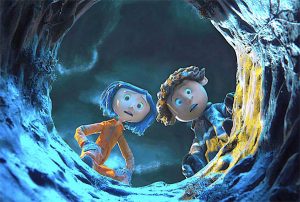 The next few nights bring more surprises. More jumping mice disturb Coraline’s sleep. When Coraline follows, the tunnel reappears in the small doorway. Coraline revisits the parallel world, and discovers even more surprising sights. Other Dad has planted an exterior garden with flowers that move and sway, and a gardening device that takes Dad and Coraline aloft, to reveal the entire garden is laid out in a pattern that mimics Coraline’s face. A special cake from Mom self-writes the words in icing, “Welcome home.” A boy parallel to the neighbor boy is introduced to her to be her new friend – also with button eyes, and allegedly “fixed” by Mom so that he doesn’t do the thing Coraline found most aggravating about the boy from her former world – talk. And an invitation is received for Coraline to go upstairs to the acrobat’s apartment for a special surprise. Coraline and the mute boy climb the stairs to the roof apartment, and knock at the door. The door twirls as if pivoted on a bar inserted in its mid-section, and scoops the two children inside. The corridor is lined with two opposite rows of miniature cannon, each of which begins shooting out sticks of cotton candy. A device shaped like a miniature Ferris wheel spins bags of popcorn, “laid” from the rear of a mechanical chicken as if laying eggs into the sacks.
The next few nights bring more surprises. More jumping mice disturb Coraline’s sleep. When Coraline follows, the tunnel reappears in the small doorway. Coraline revisits the parallel world, and discovers even more surprising sights. Other Dad has planted an exterior garden with flowers that move and sway, and a gardening device that takes Dad and Coraline aloft, to reveal the entire garden is laid out in a pattern that mimics Coraline’s face. A special cake from Mom self-writes the words in icing, “Welcome home.” A boy parallel to the neighbor boy is introduced to her to be her new friend – also with button eyes, and allegedly “fixed” by Mom so that he doesn’t do the thing Coraline found most aggravating about the boy from her former world – talk. And an invitation is received for Coraline to go upstairs to the acrobat’s apartment for a special surprise. Coraline and the mute boy climb the stairs to the roof apartment, and knock at the door. The door twirls as if pivoted on a bar inserted in its mid-section, and scoops the two children inside. The corridor is lined with two opposite rows of miniature cannon, each of which begins shooting out sticks of cotton candy. A device shaped like a miniature Ferris wheel spins bags of popcorn, “laid” from the rear of a mechanical chicken as if laying eggs into the sacks.
And at the end of the corridor is a light-filled miniature circus tent. The two children crawl through the canvas flap of the tent, to find an arena much bigger than the tent itself inside, where the voice of the acrobat announces over a loudspeaker the amazing jumping-mouse circus. In a sequence elaborate in placement of characters (which would have benefitted greatly by more fluid animation as in Laika’s later features), a troupe of circus-costumed white mice, decked out with miniature marching band instruments, performs a well-choreographed circular parade in the center ring, hopping in lines, spirals, etc. to the conducting of a bandmaster mouse hopping atop a small red rubber ball with a gold star on it. The parade climaxes with the mice assuming an acrobatic formation, spelling out Coraline’s name with their limbs and tails. A tall spiral platform emerges from nowhere, towering high in the center ring, and picking up most of the band on the edges of its spiral. The bandmaster mouse winds up atop the very pinnacle of the structure, and rolls down the spiral path on his ball, forcing the other mice to jump off the ledge as he passes. When he reaches the bottom, the structure collapses back into the floor, revealing the acrobat within, dressed in snappy attire as a ringmaster, his moustache now neatly curled instead of frazzled, and also with button eyes. He thanks the kids for their applause, and Coraline for calling him “amazing” – the billing he’s been claiming he was entitled to all along in the real world. The kids leave with cotton candy still stuck to the boy, and an invitation to return anytime.
Another visit results in an invite to the “other” pair of elderly stage performers. Coraline enters their door, now decked with neon trimming, to find a full-sized theater built within the apartment – the audience consisting entirely of Scottie dogs, except for front-row seats reserved for Coraline and the mute boy. A stage act is presented, in which the sisters appear in operetta style, embarrassingly near-naked as a mermaid and in the guise of the Birth of Venus. More extreme still, they climb at opposite ends of the stage to trapeze platforms, and seem about to engage in a trapeze act that would certainly not seem appropriate for their age or buxom stage of overweightness. Suddenly, each unzips her “skin”, revealing inside a shapely, youthful version of themselves as they must have been in their original heyday. They gracefully swing out on trapeze, one catching the other, then reach down for Coraline, sweeping her from her seat into the act. After several swings above the dog audience, Coraline is set down, while the sisters gracefully fling themselves into a barrel of water on the stage for a finale.
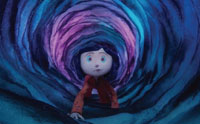 Too good to be true? Well, maybe so, but it’s not a dream, either. Coraline finds one familiar face in her alternate world – the black cat, who does not have button eyes. And strangely, in the parallel world, the cat can talk in plain English. He claims to come and go as he pleases between the two existences, despite other Mom disapproving of him. He also cautions in not-so-straightforward fashion that all is not as it seems, and that other Mom may prove a danger if angered. He also provides clues to suggest that the disappearance of the sister of the boy’s grandmother in the real world may have been caused by other Mom – and perhaps could happen to Coraline, too. Things come to a head when other Mom and Dad suggest that Coraline can stay with them always in the cool alternate world, if she does just one tiny thing – accept a pair of black shoe buttons as her new eyes (or, if she prefers, similar buttons in other colors). Coraline is shocked, and requests to “sleep on it”, hoping that when she awakes, she will be back in her own room in the real world as usual. This time, she wakes up still in the fancy bed of the alternate universe. A refusal to take on the buttons rouses other Mom’s anger, and she morphs from her form as a duplicate of Coraline’s real Mom, onto a taller, more grotesque figure without button eyes – not fully explained, but some kind of a witch or sorceress, who has created this whole world as a custom lure for Coraline, much in the manner of a gingerbread house in Hansel and Gretel. It is deduced that the button-eyed doll in the real world of Coraline’s room has served as the witch’s eyes, to allow her to determine all of Coraline’s secret desires and dreams. Coraline is locked in a closet with a mysterious one-way door sealing off her escape until she learns to “obey her mother”, and encounters the spirits of three children – one of them the long-lost sister previously mentioned, all of whom have given up their eyes, and somehow had their bodies devoured, while their spirits were locked away forever. They, however, claim that if Coraline can find their lost eyes, their spirits would be freed from other Mom’s spell. A crash through the door frees Coraline, as the other-boy mute dares to disobey Mom, setting Coraline free. Coraline escapes back through the tunnel, but finds that other Mom has somehow gotten one step ahead of her, spiriting away her real Mom and Dad into the parallel world to lure her back in. (Things get complicated (if not already) from this point on, as the ending of the film seems to contradict this sequence, revealing real Mom and Dad only out on an errand – so were they really captured or not, as they seem to have no memories of events?). Coraline returns, challenging other Mom with a wager to set everyone free if she can locate the ghosts’ missing eyes and her parents too, but agree to give up her eyes if she loses. A high-stakes game of hide and seek climaxes the film, with the final set of ghost eyes being hidden inside the red ball of the mice circus’s bandmaster mouse. Eventually, the witch-created other world disintegrates pixel by pixel, and everything somehow turns out right at the end, with the prospect that Mom and Dad are finally in a position to pay more attention to Coraline, and the neighbors aren’t quite so boring as Coraline had them sized up to be. Be satisfied with what you’ve got.
Too good to be true? Well, maybe so, but it’s not a dream, either. Coraline finds one familiar face in her alternate world – the black cat, who does not have button eyes. And strangely, in the parallel world, the cat can talk in plain English. He claims to come and go as he pleases between the two existences, despite other Mom disapproving of him. He also cautions in not-so-straightforward fashion that all is not as it seems, and that other Mom may prove a danger if angered. He also provides clues to suggest that the disappearance of the sister of the boy’s grandmother in the real world may have been caused by other Mom – and perhaps could happen to Coraline, too. Things come to a head when other Mom and Dad suggest that Coraline can stay with them always in the cool alternate world, if she does just one tiny thing – accept a pair of black shoe buttons as her new eyes (or, if she prefers, similar buttons in other colors). Coraline is shocked, and requests to “sleep on it”, hoping that when she awakes, she will be back in her own room in the real world as usual. This time, she wakes up still in the fancy bed of the alternate universe. A refusal to take on the buttons rouses other Mom’s anger, and she morphs from her form as a duplicate of Coraline’s real Mom, onto a taller, more grotesque figure without button eyes – not fully explained, but some kind of a witch or sorceress, who has created this whole world as a custom lure for Coraline, much in the manner of a gingerbread house in Hansel and Gretel. It is deduced that the button-eyed doll in the real world of Coraline’s room has served as the witch’s eyes, to allow her to determine all of Coraline’s secret desires and dreams. Coraline is locked in a closet with a mysterious one-way door sealing off her escape until she learns to “obey her mother”, and encounters the spirits of three children – one of them the long-lost sister previously mentioned, all of whom have given up their eyes, and somehow had their bodies devoured, while their spirits were locked away forever. They, however, claim that if Coraline can find their lost eyes, their spirits would be freed from other Mom’s spell. A crash through the door frees Coraline, as the other-boy mute dares to disobey Mom, setting Coraline free. Coraline escapes back through the tunnel, but finds that other Mom has somehow gotten one step ahead of her, spiriting away her real Mom and Dad into the parallel world to lure her back in. (Things get complicated (if not already) from this point on, as the ending of the film seems to contradict this sequence, revealing real Mom and Dad only out on an errand – so were they really captured or not, as they seem to have no memories of events?). Coraline returns, challenging other Mom with a wager to set everyone free if she can locate the ghosts’ missing eyes and her parents too, but agree to give up her eyes if she loses. A high-stakes game of hide and seek climaxes the film, with the final set of ghost eyes being hidden inside the red ball of the mice circus’s bandmaster mouse. Eventually, the witch-created other world disintegrates pixel by pixel, and everything somehow turns out right at the end, with the prospect that Mom and Dad are finally in a position to pay more attention to Coraline, and the neighbors aren’t quite so boring as Coraline had them sized up to be. Be satisfied with what you’ve got.
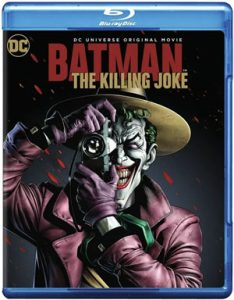 Batman: The Killing Joke (7/25/16) is not among my favorite Batman adventures, though it does represent a milestone as the last voice team-up between Kevin Conroy as Batman and Mark Hamill as the Joker. Unfortunately, while visually retaining much of the look of the original series, it goes for a darker story vibe with blood, violence and adult angles over and above the tolerance levels and understanding of the kids, and renders the Joker overall too sadistic to fully enjoy the humor in Mark Hamill’s otherwise-excellent reads. Perhaps this is some people’s idea of the twisted complexities of the Joker’s persona. But I never recall it from the original Bob Kane comics, and found it easier to appreciate the character simplistically when he was a threatening menace but never succeeded in permanently altering or snuffing out people’s lives, and the bullets flew but bever seemed to find a vital mark.
Batman: The Killing Joke (7/25/16) is not among my favorite Batman adventures, though it does represent a milestone as the last voice team-up between Kevin Conroy as Batman and Mark Hamill as the Joker. Unfortunately, while visually retaining much of the look of the original series, it goes for a darker story vibe with blood, violence and adult angles over and above the tolerance levels and understanding of the kids, and renders the Joker overall too sadistic to fully enjoy the humor in Mark Hamill’s otherwise-excellent reads. Perhaps this is some people’s idea of the twisted complexities of the Joker’s persona. But I never recall it from the original Bob Kane comics, and found it easier to appreciate the character simplistically when he was a threatening menace but never succeeded in permanently altering or snuffing out people’s lives, and the bullets flew but bever seemed to find a vital mark.
The story is not told lineally, but rather randomly switches around between the present and multiple levels of flashback, some set in grayer tones only to clarify to the audience that we have returned to a flashback instead of to the next scene in the present story. One level of flashback tracks the origins of the Joker, including the usual factory confrontation with Batman and fall into a vat of chemicals that transformed the Joker’s skin to its pasty whiteness, but also inventing a new background where Joker, pre-accident, was a struggling stand-up comic with a wife and expectant family, who couldn’t seem to get a laugh on stage. His financial problems lead him to a union with the underworld, a failed involvement in a caper, and his climactic brush with the caped crusader, leading to his industrial accident and madness. Another level of flashback deals with Barbara Gordon, alias Batgirl, and a rather puzzling and controversial love/hate schism that develops between her and Bruce Wayne that ultimately ends in her hanging up the cape for good. In the present-day story, Joker has once again escaped from Arkham, leaving a doppelganger in clown makeup occupying the cell in his place. Batman suspects something from recent activity, and unmasks the imposter. Joker meanwhile has formed an allegiance with new thugs, and acquires by force an out-of-business carnival for sale. A line that is humorous though well past standards to pass for use in the original series has Joker complaining to the seller about the stench of piss about the place, which he can’t quite place between rats or derelicts – adding that he is an expert on eau de toilet. Joker has also somehow formed allegiance with a legion of circus freaks, and sets the place up as a headquarter for mental torture of who he refers to as his “star attraction” – Commissioner Gordon. Jojer claims in the story that he is out to prove a point – how madness can be induced through experiencing just one bad day.
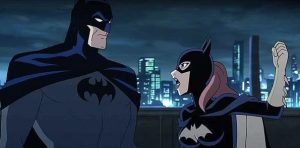 Joker and several thugs unexplainedly storm the Commissioner’s home (which appears to have no external guard or security – does nobody think of these things for a top civil servant?) Brutally, Joker places a rifle at the belly of Barbara, who answers the door, and a shot rings out, leaving Barbara covered in blood and immobile upon the floor, with Joker comparing her to a book with the “spine damaged”. The Commissioner is taken prisoner and spirited away to the carnival, where he is stripped like an animal, manacled and caged (fortunately, the producers draw the line at any images of nudity of crucial areas), subjected to humiliation and jeering by the freaks, and ridden through a video funhouse where Joker appears on endless TV big screens with a song promoting the virtues of madness, and a montage of images of the wounded Barbara, apparently taken by one of the thugs during the attack. The Commissioner collapses, spoiling the Joker’s spirit of fun, and is left in his cage with hopes he will get a little livelier.
Joker and several thugs unexplainedly storm the Commissioner’s home (which appears to have no external guard or security – does nobody think of these things for a top civil servant?) Brutally, Joker places a rifle at the belly of Barbara, who answers the door, and a shot rings out, leaving Barbara covered in blood and immobile upon the floor, with Joker comparing her to a book with the “spine damaged”. The Commissioner is taken prisoner and spirited away to the carnival, where he is stripped like an animal, manacled and caged (fortunately, the producers draw the line at any images of nudity of crucial areas), subjected to humiliation and jeering by the freaks, and ridden through a video funhouse where Joker appears on endless TV big screens with a song promoting the virtues of madness, and a montage of images of the wounded Barbara, apparently taken by one of the thugs during the attack. The Commissioner collapses, spoiling the Joker’s spirit of fun, and is left in his cage with hopes he will get a little livelier.
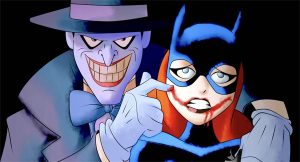 Batman meanwhile is somehow left a clue of a carnival ticket stub, and with this “free pass” is invited to the shindig. The freak army is lying in wait for his arrival, with the Commissioner prominently displayed to view, and Batman battles the performers off one by one. (While the sequence should be climactic, to me, the battle just doesn’t have the zing of the ones from the old series, and seems over too soon and without nearly enough twists and turns – give me the Joker roller coaster ride from “Be a Clown” instead any day.) Batman releases Gordon, who comes to, but has not cracked. “By the book. I want him taken by the book, so he sees the system works our way”, Gordon groans. Batman battles Joker in another fun house and hall of mirrors setting. The Joker pulls a gun, but for once has somehow confused his real revolver with one of his gag pistols with a flag that says “Bang”. The joke being on him, Joker is reduced to hand-to-hand combat with the Bat, and seems to be getting the upper hand in an upside-down room setting, with Batman prone n the floor, and Joker delivering kicks and punches. Joker repeats his goal of proving how madness can be induced by one bad day, and insightfully observes that Batman must have had such a one bad day to become the freak he is himself. While smashing crockery from the prop room over Batman’s head, the Joker speculates why Batman doesn’t crack too, and especially, “Why don’t you laugh?” Suddenly, Batman gets his second wind, and rises from the floor to clutch Joker by the throat. “Because I’ve heard it all before. And it wasn’t funny the first time.”
Batman meanwhile is somehow left a clue of a carnival ticket stub, and with this “free pass” is invited to the shindig. The freak army is lying in wait for his arrival, with the Commissioner prominently displayed to view, and Batman battles the performers off one by one. (While the sequence should be climactic, to me, the battle just doesn’t have the zing of the ones from the old series, and seems over too soon and without nearly enough twists and turns – give me the Joker roller coaster ride from “Be a Clown” instead any day.) Batman releases Gordon, who comes to, but has not cracked. “By the book. I want him taken by the book, so he sees the system works our way”, Gordon groans. Batman battles Joker in another fun house and hall of mirrors setting. The Joker pulls a gun, but for once has somehow confused his real revolver with one of his gag pistols with a flag that says “Bang”. The joke being on him, Joker is reduced to hand-to-hand combat with the Bat, and seems to be getting the upper hand in an upside-down room setting, with Batman prone n the floor, and Joker delivering kicks and punches. Joker repeats his goal of proving how madness can be induced by one bad day, and insightfully observes that Batman must have had such a one bad day to become the freak he is himself. While smashing crockery from the prop room over Batman’s head, the Joker speculates why Batman doesn’t crack too, and especially, “Why don’t you laugh?” Suddenly, Batman gets his second wind, and rises from the floor to clutch Joker by the throat. “Because I’ve heard it all before. And it wasn’t funny the first time.”
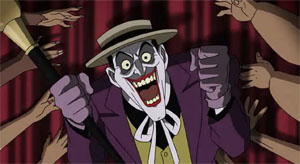 A few well-placed blows place the Joker in prone position, and Joker complacently anticipates the part where Batman “beats the crap” out of him. But Batman points out that the Commissioner told him to bring Joker in “by the book”, and that the Joker’s experiment had not succeeded in bringing about madness in either the Commissioner or himself. “Maybe it’s just you”, Batman adds with emphasis, as sane people continue to keep their sanity. In an unusual moment of understanding, Batman appeals to see if there’s still a glimmer of sanity left in the Joker, pointing out that their repeated battles don’t have to ultimately end in one of them doing in the other, and offering to provide the Joker help and possible rehabilitation. Joker almost softens, but, without anger or vehemence, realistically declines the offer with the remark, “No, it’s too late for that.” The Joker prepares to be taken in quietly, but happens to remember a joke he relates to Batman – about two crazy men escaping an asylum over the rooftops. One leaps a gap between one building and another, while the second won’t jump for fear of falling. The first lunatic tells the other he has a flashlight, and will shine a beam of light across the gap for the other to walk across on. The second replies. “What do you think I am, crazy? You’d probably shut off the light when I was only halfway across.” A moment’s hesitation, then the beginnings of a smile, then an uncharacteristic hearty shared laugh with the Joker from Batman, as the Joker finally successfully delivers a stand-up punch line. (Still an odd and awkward moment as presented, which would have been much more satisfying an ending if we had not left Barbara in the hospital.) Being unfamiliar with more recent Batman comics, in which perhaps a similar fate befell Barbara, I did not fully understand the coda after the credits, and had to do some research to figure it out, as Barbara, seemingly happy and recovered but permanently wheelchair bound, converts to a secret computer monitoring station and a new identity online as Oracle (not stated in the film), settling in at her keyboards and remarking “Let’s get back to work.”
A few well-placed blows place the Joker in prone position, and Joker complacently anticipates the part where Batman “beats the crap” out of him. But Batman points out that the Commissioner told him to bring Joker in “by the book”, and that the Joker’s experiment had not succeeded in bringing about madness in either the Commissioner or himself. “Maybe it’s just you”, Batman adds with emphasis, as sane people continue to keep their sanity. In an unusual moment of understanding, Batman appeals to see if there’s still a glimmer of sanity left in the Joker, pointing out that their repeated battles don’t have to ultimately end in one of them doing in the other, and offering to provide the Joker help and possible rehabilitation. Joker almost softens, but, without anger or vehemence, realistically declines the offer with the remark, “No, it’s too late for that.” The Joker prepares to be taken in quietly, but happens to remember a joke he relates to Batman – about two crazy men escaping an asylum over the rooftops. One leaps a gap between one building and another, while the second won’t jump for fear of falling. The first lunatic tells the other he has a flashlight, and will shine a beam of light across the gap for the other to walk across on. The second replies. “What do you think I am, crazy? You’d probably shut off the light when I was only halfway across.” A moment’s hesitation, then the beginnings of a smile, then an uncharacteristic hearty shared laugh with the Joker from Batman, as the Joker finally successfully delivers a stand-up punch line. (Still an odd and awkward moment as presented, which would have been much more satisfying an ending if we had not left Barbara in the hospital.) Being unfamiliar with more recent Batman comics, in which perhaps a similar fate befell Barbara, I did not fully understand the coda after the credits, and had to do some research to figure it out, as Barbara, seemingly happy and recovered but permanently wheelchair bound, converts to a secret computer monitoring station and a new identity online as Oracle (not stated in the film), settling in at her keyboards and remarking “Let’s get back to work.”
 Scooby Doo has come a long way since the days of Hanna-Barbera. Since Warner Brothers took over production, a series of feature-length Scooby mysteries has seen the light on cable stations and in direct releases to home video, which show much more creativity and detail in story-plotting, often unusual action twists, and animation sophistication the limited budgets of early H-B production could have only dreamed of. Among the many favorable entries produced was Big Top Scooby Doo (10/9/12). While treading upon some old themes that may have resulted in the 70’s-80’s in just another tedious Hanna-Barbera yawner, a new batch of writer-fans prove that the material can be approached in fresh fashion with a degree of flash and class, leaving the viewer highly satisfied and entertained.
Scooby Doo has come a long way since the days of Hanna-Barbera. Since Warner Brothers took over production, a series of feature-length Scooby mysteries has seen the light on cable stations and in direct releases to home video, which show much more creativity and detail in story-plotting, often unusual action twists, and animation sophistication the limited budgets of early H-B production could have only dreamed of. Among the many favorable entries produced was Big Top Scooby Doo (10/9/12). While treading upon some old themes that may have resulted in the 70’s-80’s in just another tedious Hanna-Barbera yawner, a new batch of writer-fans prove that the material can be approached in fresh fashion with a degree of flash and class, leaving the viewer highly satisfied and entertained.
We open upon a jewelry heist in progress, as a security guard is frightened from his duties by a view of the thief – a werewolf! The creature eludes police outside, clambering up the side of a building and nimbly escaping over the rooftops, carrying a valuable gem. The beast retreats to the countryside, and bays at the moon on a hill crest overlooking a darkened circus grounds below. After credits, we focus attention on the Mystery Machine, approaching a vacation destination of Atlantic City. Shaggy takes an inventory of all the beasts and creatures they’ve encountered on their past excursions to various other national landmarks, but Velma assures him that nothing bad happens in Atlantic City, though Daphne reminds her “Only gangland murders.” Fred spots circus tents, of the same show seen previously, though now in a new town. He is keenly interested in attending the show, having recently had experience in a circus training camp (though recalling how he failed in learning trapeze due to several broken bones – in the body of the person he was supposed to catch, and a landing into a wagon causing a chain reaction that collapsed the tent). The other Scooby gang members can only yawn at Fred’s suggestion to see the show (Shaggy and Scooby preferring the possibility of seeing a rock band advertised to be in town, whose leader just happens to play upon the image and persona of being a mock-werewolf), but Fred outvotes them all 1 to 4.
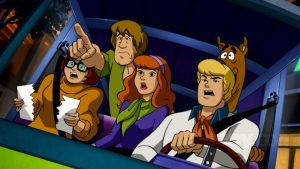 They find the show is not open for business yet, but the entrance gate is ajar, so Fred insists on having a look around. The camp seems deserted (it is later explained that the cast is taking a night off in town), and ultra-high on Shaggy’s instinctive spooky meter with everything in darkness. Separated from the others, who should Shaggy and Scooby encounter but the werewolf. Meanwhile, another occupant of the grounds is finally located – the new, youthful owner of the show, who has acquired it through recent inheritance. It seems that he is himself preoccupied in thought after learning from Fred that the gate was unlocked, though he swears he himself bolted it. The owner races through the grounds, suspecting the intrusion of the werewolf, whom he eventually relates to the gang has been dogging his show ever since he inherited it, following the show from town to town. As Shaggy and Scooby hide in a popcorn wagon, the werewolf appears right behind them, with typical shock reaction from the trembling two. The owner, of foreign accent, is not well versed upon werewolf lorem and holds out a string of garlic cloves to ward off the beast. Daphne has to inform him that garlic is for vampires, not werewolves. Eventually, the beast is scared away, as Velma throws the glare of a floodlight upon him, deciding to “throw a little light on the subject.
They find the show is not open for business yet, but the entrance gate is ajar, so Fred insists on having a look around. The camp seems deserted (it is later explained that the cast is taking a night off in town), and ultra-high on Shaggy’s instinctive spooky meter with everything in darkness. Separated from the others, who should Shaggy and Scooby encounter but the werewolf. Meanwhile, another occupant of the grounds is finally located – the new, youthful owner of the show, who has acquired it through recent inheritance. It seems that he is himself preoccupied in thought after learning from Fred that the gate was unlocked, though he swears he himself bolted it. The owner races through the grounds, suspecting the intrusion of the werewolf, whom he eventually relates to the gang has been dogging his show ever since he inherited it, following the show from town to town. As Shaggy and Scooby hide in a popcorn wagon, the werewolf appears right behind them, with typical shock reaction from the trembling two. The owner, of foreign accent, is not well versed upon werewolf lorem and holds out a string of garlic cloves to ward off the beast. Daphne has to inform him that garlic is for vampires, not werewolves. Eventually, the beast is scared away, as Velma throws the glare of a floodlight upon him, deciding to “throw a little light on the subject.
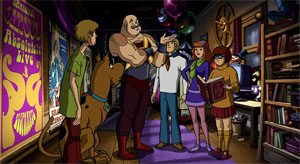 The owner informs the gang in a conference in his wagon of the repeated appearances of the werewolf since his acquisition of the circus, frightening away his customers and many performers. It also is revealed that the towns they have visited since he took over also seem to have had a concurrent run of jewel robberies. Is there a connection? Why would a werewolf want jewelry? Velma consults a computer, remembering a case of werewolves in ancient Europe, where a werewolf discovered that a certain combination of gemstones could allow control of his powers, to transform to a wolf and back at will instead of at the whims of a full moon. The European werewolf had bitten others and formed a legion of his kind with which he shared his secret powers, allowing them to dominate and terrorize a region as an army for many years. It appears from the variety of stones taken in the thefts that the present werewolf is attempting to duplicate the secret of the European ones. The gang asks if anyone among the troupe is a possible suspect for being the werewolf, and who might hold a grudge against the circus as well.
The owner informs the gang in a conference in his wagon of the repeated appearances of the werewolf since his acquisition of the circus, frightening away his customers and many performers. It also is revealed that the towns they have visited since he took over also seem to have had a concurrent run of jewel robberies. Is there a connection? Why would a werewolf want jewelry? Velma consults a computer, remembering a case of werewolves in ancient Europe, where a werewolf discovered that a certain combination of gemstones could allow control of his powers, to transform to a wolf and back at will instead of at the whims of a full moon. The European werewolf had bitten others and formed a legion of his kind with which he shared his secret powers, allowing them to dominate and terrorize a region as an army for many years. It appears from the variety of stones taken in the thefts that the present werewolf is attempting to duplicate the secret of the European ones. The gang asks if anyone among the troupe is a possible suspect for being the werewolf, and who might hold a grudge against the circus as well.
It is decided (mostly at Fred’s urging) that the gang join the show to work among the performers and simultaneously scout around for possible clues and suspects. Fred volunteers for trapeze despite his mishaps, stating that he at least knows the most important rules – don’t fall, nd don’t drop anybody. Shaggy and Scooby are appropriately pegged for an animal act, though the owner is in the process of phasing out animal acts as no longer desired by the public. Daphne, though demonstrating incredible skill at riding a stunt motorcycle, is also appointed to assist the clowns. And Velma, largely by default as to remaining positions to be filled, is reluctantly appointed the “human comet” for launch by cannon (which is only preferable over alternative positions of knife throwing, fire eating, and sword swallowing).
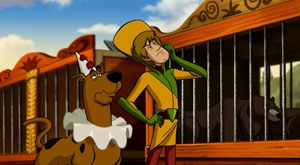 The suspect list grows. An animal trainer is still among the cast, but with the animal acts being phased out, claims he was ready to retire anyway, and is only hanging on with the show until they reach an upcoming destination where his animals will be accepted by a zoo. He shows off to Shaggu and Scooby his favorites – a group of large baboons, who respond to Spanish-language verbal commands, and also mimic any movement or gesture by humans (allowing Shaggy and Scooby to have a ball playing monkey-see, monkey-doo with them). Daphne meets the clowns, one of whom is a frustrated theatrical thespian lowered to this form of entertainment, and still holding considerable personal bitterness about it. Velma is partnered with a strong man to assist her into the cannon, who seems all right but is definitely burly enough to pass as a werewolf. (Velma’s cannon practice goes roughly, as the cannon’s blast shoots her leotards out of the muzzle but not Velma, who appears bare-shouldered out of the cannon mouth, apologizing, “Sorry, I stiffened up.”) And Fred encounters a pair of trapeze artists, male and female, the former insanely jealous, while the second makes flirtatious moves toward Fred. It also turns out that the rock band Shaggy idolizes, Wolvesmoon, has also been playing the same circuit of towns as the circus, making them also possible suspects.
The suspect list grows. An animal trainer is still among the cast, but with the animal acts being phased out, claims he was ready to retire anyway, and is only hanging on with the show until they reach an upcoming destination where his animals will be accepted by a zoo. He shows off to Shaggu and Scooby his favorites – a group of large baboons, who respond to Spanish-language verbal commands, and also mimic any movement or gesture by humans (allowing Shaggy and Scooby to have a ball playing monkey-see, monkey-doo with them). Daphne meets the clowns, one of whom is a frustrated theatrical thespian lowered to this form of entertainment, and still holding considerable personal bitterness about it. Velma is partnered with a strong man to assist her into the cannon, who seems all right but is definitely burly enough to pass as a werewolf. (Velma’s cannon practice goes roughly, as the cannon’s blast shoots her leotards out of the muzzle but not Velma, who appears bare-shouldered out of the cannon mouth, apologizing, “Sorry, I stiffened up.”) And Fred encounters a pair of trapeze artists, male and female, the former insanely jealous, while the second makes flirtatious moves toward Fred. It also turns out that the rock band Shaggy idolizes, Wolvesmoon, has also been playing the same circuit of towns as the circus, making them also possible suspects.
A shadow appears on the grounds one night. It is the werewolf again, this time sneaking up behind the thespian clown. There is a struggle, and sounds are heard as the camera fades out suggesting that the wolf has put the bite on him. Next day, the clown is nowhere to be found, Worse yet, that night, Shaggy and Scooby witness another jewelry heist in town – with two werewolves, one dressed in the shirt of the former clown.
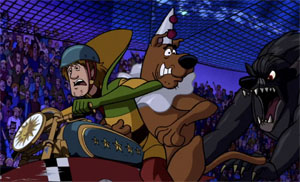 The show must nevertheless go on. At the evening performance, Shaggy and Scooby score the hit, Scooby proving to be an instinctive circus natural, balancing atop a large ball while juggling bowling pins and then flaming torches (which he extinguishes with an exhibition of fire-eating). Shaggy, not quite knowing why he is in the act himself at all, falsely responds to the cheers of the crowd “And I’m his trainer.” The crowd’s cheers change to a chant of “Shaggy! Shaggy!”, while Scooby wonder just what happened, everyone now appearing to give him no credit at all for his own feats. The performance is interrupted by the appearance of the werewolf duo. Various action escapades ensue, with a clown car and the motorcycle coming into play as Scooby and Shaggy ride the high wire and spin inside a metal ball of doom, while Fred attempts to throw the trapeze net over the beasts, but somehow the monsters escape.
The show must nevertheless go on. At the evening performance, Shaggy and Scooby score the hit, Scooby proving to be an instinctive circus natural, balancing atop a large ball while juggling bowling pins and then flaming torches (which he extinguishes with an exhibition of fire-eating). Shaggy, not quite knowing why he is in the act himself at all, falsely responds to the cheers of the crowd “And I’m his trainer.” The crowd’s cheers change to a chant of “Shaggy! Shaggy!”, while Scooby wonder just what happened, everyone now appearing to give him no credit at all for his own feats. The performance is interrupted by the appearance of the werewolf duo. Various action escapades ensue, with a clown car and the motorcycle coming into play as Scooby and Shaggy ride the high wire and spin inside a metal ball of doom, while Fred attempts to throw the trapeze net over the beasts, but somehow the monsters escape.
An old, old text on the European werewolves somehow finds its way into the owner’s bookshelf, though the owner had previously claimed to have never heard of the historic incident. Is the owner behind the werewolves? Or did someone merely plant the book there to avoid suspicion? Velma does some checking in the text, and discloses to the gang and troupe that the only jewel not yet stolen from the circled gem list in the book is a “carbonado” – a stone neither Velma nor anyone else claims to have heard of. Meanwhile, a business-like man arrives to meet the circus owner, arranging a booking for a private performance of the show for the entourage of Wolvesmoon. Shaggy is overcome with excitement, having to breathe into a paper bag to regain his normal semi-sanity. But a further disclosure in private to the gang by Velma reveals that a carbonado is also known as a black diamond. Shaggy needs the bag again, realizing that the lead singer of Wolvesmoon wears just such an amulet upon his chest.
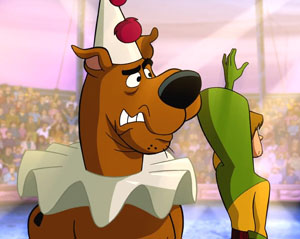 Between this incident and the private performance, several other cast members go missing, including the owner/ringmaster, leaving the gang to presume more werewolf abductions are occurring, and each of the gang have to assume additional duties to keep the show running, including Fred doubling as ringmaster. (He blows duplicating the ringmaster’s introduction at the private performance, referring to the performers as being drawn from the ten continents of the globe. The band manager comments to the leader that aren’t there only seven continents, while the leader shrugs it off, under the impression that they’re discovering new ones all the time.) Scooby is still in a tiff about Shaggy taking all the credit for their act (including the affections of many local girls), and has to be bribed into performing with a wheelbarrow full of Scooby snacks. This time, the werewolves attack en masse, multiple new ones appearing, wearing articles of clothing from the additional missing performers. Among their terrorizing efforts, they seize the black diamond from a chain around the band leader’s neck. But during the melee, Shaggy gets a grip upon the arm of one of the wolves, causing the fur to tear away like fabric, revealing the brown fur of a baboon beneath. It is realized the wolves are actually the baboon troupe in disguises – pointing suspicion directly at their trainer. A last “wolf” remains after the gang’s efforts to round up the intruders, and Velma subdues the fleeing lone wolf by having herself fired out of the cannon, landing atop him. The unmasking reveals the trainer inside. He attempts to run again, but a shot from a tranquilizer dart gun puts him out of commission. The gun is held by the strong man, who claims to have been among the captive performers, housed in several metal storage bins on the outskirts of the circus grounds, and to have broken his rope bonds, displaying a rope strand neatly parted.
Between this incident and the private performance, several other cast members go missing, including the owner/ringmaster, leaving the gang to presume more werewolf abductions are occurring, and each of the gang have to assume additional duties to keep the show running, including Fred doubling as ringmaster. (He blows duplicating the ringmaster’s introduction at the private performance, referring to the performers as being drawn from the ten continents of the globe. The band manager comments to the leader that aren’t there only seven continents, while the leader shrugs it off, under the impression that they’re discovering new ones all the time.) Scooby is still in a tiff about Shaggy taking all the credit for their act (including the affections of many local girls), and has to be bribed into performing with a wheelbarrow full of Scooby snacks. This time, the werewolves attack en masse, multiple new ones appearing, wearing articles of clothing from the additional missing performers. Among their terrorizing efforts, they seize the black diamond from a chain around the band leader’s neck. But during the melee, Shaggy gets a grip upon the arm of one of the wolves, causing the fur to tear away like fabric, revealing the brown fur of a baboon beneath. It is realized the wolves are actually the baboon troupe in disguises – pointing suspicion directly at their trainer. A last “wolf” remains after the gang’s efforts to round up the intruders, and Velma subdues the fleeing lone wolf by having herself fired out of the cannon, landing atop him. The unmasking reveals the trainer inside. He attempts to run again, but a shot from a tranquilizer dart gun puts him out of commission. The gun is held by the strong man, who claims to have been among the captive performers, housed in several metal storage bins on the outskirts of the circus grounds, and to have broken his rope bonds, displaying a rope strand neatly parted.
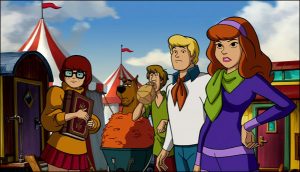 The case appears wrapped up, though the location of the jewels is not yet known. The powerful drug in the dart shot into the trainer will leave him unconscious for hours to days, so Daphne is disappointed she will not get to hear the standard “And I would have gotten away with it except for…” line. The owner departs with a full cashbox, along with his performers aboard a modern streamlined circus train, and it is presumed the jewels will be discovered when the trainer revives and confesses. As the train pulls out, Velma still has the feeling that something is not right. Those ropes the strong man “escaped” from looked cleanly cut, not snapped by brute force. And his convenient shot to silence the trainer might have been an effort to hush him up. Velma surmises that the strong man may have been in on the whole setup. The gang piles into the Mystery Machine, realizing (in unexpected fashion for the series) that the case is not solved yet, and speeds after the train in attempt to intercept it. The strong man is indeed observed through the windows of the train, roughing up the owner, and swiping the cash box. Shaggy and Scooby are recruited, with considerable prodding, to make a leap from the roof of the Mystery Machine onto the roof of the moving train. But the road they are driving on suddenly veers away from proximity to the tracks, preventing any more of the gang from following, leaving only Shaggy and Scooby to face the villain. They manage to slip down into the owner’s car unnoticed, snatching away the cash box from behind the villain while he continues to rough up the owner. When the strong man becomes aware of their presence, he reaches for his tranquilizer gun, but finds no darts within. Shaggy has also picked his pocket while turned around, and now carries a handful of darts in his own trousers. A suspenseful chase ensues, featuring good use of 3-D animation effects on train and countryside, as our heroes and the villain take to the train roofs, in a pursuit leading toward the engine. A low tunnel inevitably looms ahead, causing all to duck themselves flat against the train roofs. Periodic lighting within the tunnel reveals the villain creeping closer and closer to out heroes on his belly. Shaggy and Scooby are running out of cars as the train emerges from the tunnel, but Shaggy has an idea. He and Scooby drop down over the edge of the last passenger car, seemingly falling behind the fuel car. The villain wonders what has happened to them, and leans down to peer over the roof edge. Shaggy and Scooby are holding on to ladder rungs of the car’s front side, and Shaggy’s arm swings out with the handful of tranquilizer darts, scoring a direct hit upon the strong man’s nose. Nighty-night, big boy.
The case appears wrapped up, though the location of the jewels is not yet known. The powerful drug in the dart shot into the trainer will leave him unconscious for hours to days, so Daphne is disappointed she will not get to hear the standard “And I would have gotten away with it except for…” line. The owner departs with a full cashbox, along with his performers aboard a modern streamlined circus train, and it is presumed the jewels will be discovered when the trainer revives and confesses. As the train pulls out, Velma still has the feeling that something is not right. Those ropes the strong man “escaped” from looked cleanly cut, not snapped by brute force. And his convenient shot to silence the trainer might have been an effort to hush him up. Velma surmises that the strong man may have been in on the whole setup. The gang piles into the Mystery Machine, realizing (in unexpected fashion for the series) that the case is not solved yet, and speeds after the train in attempt to intercept it. The strong man is indeed observed through the windows of the train, roughing up the owner, and swiping the cash box. Shaggy and Scooby are recruited, with considerable prodding, to make a leap from the roof of the Mystery Machine onto the roof of the moving train. But the road they are driving on suddenly veers away from proximity to the tracks, preventing any more of the gang from following, leaving only Shaggy and Scooby to face the villain. They manage to slip down into the owner’s car unnoticed, snatching away the cash box from behind the villain while he continues to rough up the owner. When the strong man becomes aware of their presence, he reaches for his tranquilizer gun, but finds no darts within. Shaggy has also picked his pocket while turned around, and now carries a handful of darts in his own trousers. A suspenseful chase ensues, featuring good use of 3-D animation effects on train and countryside, as our heroes and the villain take to the train roofs, in a pursuit leading toward the engine. A low tunnel inevitably looms ahead, causing all to duck themselves flat against the train roofs. Periodic lighting within the tunnel reveals the villain creeping closer and closer to out heroes on his belly. Shaggy and Scooby are running out of cars as the train emerges from the tunnel, but Shaggy has an idea. He and Scooby drop down over the edge of the last passenger car, seemingly falling behind the fuel car. The villain wonders what has happened to them, and leans down to peer over the roof edge. Shaggy and Scooby are holding on to ladder rungs of the car’s front side, and Shaggy’s arm swings out with the handful of tranquilizer darts, scoring a direct hit upon the strong man’s nose. Nighty-night, big boy.
As the second villain is taken away in heavy bondage by squad car, he finally utters, in heavy foreign dialect that makes liberal substitutions for the expected words, the equivalent of the “Meddling kids” closing line. Regardless of the broken-English, Daphne finds this music to her ears. The cash and the missing jewels are retrieved from the strong man’s possession, and the black diamond returned to the rock band leader. The leader returns the favor, by booking a private concert just for the Scooby gang. Scooby himself leaps onto the stage and twangs a guitar with the leader for a howling duet, and a “Scooby Dooby Doo”, for the iris out.
The grand finale, next week.


 Charles Gardner is an animation enthusiast who toils by day as a member of LA Law – but by nights and weekends indulges in classic jazz and ragtime as a performer; and studies classic Hollywood cartoons… maybe a little too much.
Charles Gardner is an animation enthusiast who toils by day as a member of LA Law – but by nights and weekends indulges in classic jazz and ragtime as a performer; and studies classic Hollywood cartoons… maybe a little too much.


































































































































































Jonathan Harris, playing an insect in two different animated features involving circuses, both of them covered here in consecutive weeks? Oh, the pain… the pain!
I really need to check out “Big Top Scooby-Doo”. That clip of the first ten minutes is terrific, with some very funny moments as well as some genuinely scary ones. I love “Scooby-Doo: Mystery Incorporated” and have watched the whole series through three times, and each time I do I marvel at how far the franchise has progressed from its origins. Any Scooby-Doo features made circa 2012 with it are bound to be on a par with it.
“Pinocchio’s entire audience during the previous performance had in reality been lifeless puppets….” Yeah, I’ve played gigs like that, too.
Hey, I thought Harris was one of the funniest parts of “Freakizoid”.
I agree! “Lost in Space” was my favourite show when I was a kid, and I love that guy — indeed!
During the entry referring to Filmation’s Pinocchio I spent some time trying to guess which original product this was supposed to be a sequel to. I finally assumed it would be a reference to the 1940 Disney classic. Well, I’m sorry to report that neither Disney “Never Owned Or Paid For The Original” and that his version takes as many liberties with the real thing as this one does. Of course, Disney’s is a pinacle in cartoon history and this one… well…
In any case, the detailed plot of Filmation’s take indicates that the chronicler responsible for referring to Carlo Collodi’s classic as if it were an original Disney creation has paid for his very light-hearted approach. A high price indeed!
According to Jerry Beck’s THE ANIMATED MOVIE GUIDE, the Walt Disney Company thought “Pinocchio and the Emperor of the Night” was similar enough to their own 1940 classic that they sued Filmation Associates for copyright infringement — and lost.
I can hear those lawyers right now: “… and what about that guy Collodi?”
Speaking of Scooby, there was an episode of “13 Ghost of Scooby-Doo” called “The Ghouliest Show on Earth” (which was the next to last episode) where Scooby and friends go to his hometown of Dooville where a mysterious circus comes to town which in reality is a disguised group of demons by the power of a magical hypnotic calliope that wants the Chest of Demons.
One can argue how closely PATEOTHN is riding Disney’s coattails. Any adaptation or sequel to a work that already has a “definitive” dramatization has to deal with audience assumptions. You can make clear this is a new, unrelated, work. Or you can reference the more famous version for plot points, characterizations, and general audience goodwill so far as their lawyers let you.
Aside from a Jiminy Cricket clone, PATEOTN doesn’t seem to borrowing more than the name recognition and general goodwill of Disney’s classic. But to announce multiple “sequels” to famous Disney titles was just begging for trouble.
Recalling that Filmation’s first official feature, JOURNEY BACK TO OZ, implied direct lineage from the Judy Garland musical, including Garland’s daughter Liza Minelli as the voice of Dorothy and original witch Margaret Hamilton as Auntie Em. Before that, future Filmation founders made PINOCCHIO IN OUTER SPACE, also nominally a what-happened-next story, but clearly set in the present with no visual or tonal echos of Disney.
Rankin-Bass’s MAD MONSTER PARTY is populated by careful knockoffs of the Universal Studio horrors — like a lot of horror projects. The Wolfman becomes the Werewolf, the Creature has no identifying address, and the Monster’s makeup skirts Universal’s trademark version. The daddy of them all, Karloff, voices a Baron Frankenstein that caricatures both the actor and the original Universal monster. Rankin-Bass incidentally produced a syndicated serial THE NEW ADVENTURES OF PINOCCHIO and an unrelated special PINOCCHIO’S CHRISTMAS, the latter showing traces of Disney influence. Also a Saturday morning show starring Mr. Toad and the Reluctant Dragon, both created by Kenneth Grahame but perhaps most famous in their Disney incarnations.
Hanna-Barbara’s shows were often products of the zeitgeist, but the one real “mockbuster” that comes to mind was OLIVER AND THE ARTFUL DODGER, created for ABC’s “Saturday Superstar Movie”. It was an unofficial sequel to the stage/movie musical “Oliver”, reuniting the two characters on a sort of treasure hunt spotted with songs.
Last one out turn off the computer.
I take it you will be looking at both Madagascar 3 and the Open Season sequel with Boog the bear in the circus in your next article.
Quick correction: The Killing Joke was not “the last voice team-up between Kevin Conroy as Batman and Mark Hamill as the Joker.” That was series 1, episode 13 of “Scooby Doo and Guess Who”, titled “What a Night, for a Dark Knight,” which dates from 2019.